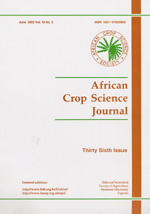
|
African Crop Science Journal
African Crop Science Society
ISSN: 1021-9730
EISSN: 1021-9730
Vol. 7, No. 4, 1999, pp. 503-510
|
 Bioline Code: cs99041
Bioline Code: cs99041
Full paper language: English
Document type: Research Article
Document available free of charge
|
|
|
African Crop Science Journal, Vol. 7, No. 4, 1999, pp. 503-510
| en |
Plant Parasitic Nematodes Associated with Common Bean In Kenya and the Effect of Meloidogyne Infection On Bean Nodulation
Kimenju, J.W.; Karanja, N.K. & Macharia, I.
Abstract
A study to determine the distribution and population densities of plant parasitic nematodes associated with beans was undertaken in Kakamega, Kiambu, Machakos and Siaya districts of Kenya. Soil and root samples were taken from 25 randomly selected farms in each district. Nematodes in the genera Meloidogyne, Pratylenchus, Scutellonema and Helicotylenchus were frequently recovered in the rhizophere of bean plants with varying densities in the different locations of the study. Meloidogyne spp. and Pratylenchus spp. were the most predominant endoparasites occurring in 86 and 61% of the root samples, respectively. Scutellonema and Helicotylenchus species were present in 80 and 59% of the soil samples, respectively. Other nematodes found in association with bean plants were in the genera Tylenchorhynchus, Tylenchus, Criconemella, Aphelenchus, Hemicyliophora, and Trichodorus. Greenhouse tests were conducted to determine the effect of M. incognita infection on nodulation of bean genotypes. With the exception of bean genotype M28, Meloidogyne infection caused significant (P< 0.05) reductions in nodulation. In a second pot experiment, bean cv. GLP-24 was inoculated with Rhizobium leguminosarum bv. phaseoli alone and in various combinations with M. incognita. Both nodulation and the dinitrogen fixation processes were adversely affected especially in plants where nematode inoculation preceded rhizobial inoculation.
Keywords
Bean genotypes, East African highlands, Helicotylenchus spp., Meloidogyne incognita, Pratylenchus spp., Scutellonema spp., Tylenchorhynchus spp.
|
| |
| fr |
Kimenju, J.W.; Karanja, N.K. & Macharia, I.
Résumé
Une étude pour déterminer la distribution et la densité de la population de nématodes parasitaires de plantes associés aux haricots a été initié dans les districts de Kakamega, Kiambu, Machakos et Siaya au Kenya. Les échantillons des racines et de sols ont été pris dans 25 fermes sélectionnées aléatoirement dans chaque districts. Les nématodes des genres Meloidogyne, Pratylenchus, Scutellonema et Helicotylenchus ont été fréquemment trouvés dans la rhizosphère des plantes de haricot avec des densité variées dans differentes parties du pay. Meloidogyne spp. et Pratylenchus spp. étaient des endoparasites les plus dominants apparaissant dans 86 et 67% d’échantillons de racines, respectivement. Les espèces de Scutellonema et Helicotylenchus étaient présents dans 80 et 59% d’échantillons de sol respectivement. Autres nématode trouvés en assoication avec la plante de haricot étaient des genres de Tylenchorhynchus, Tylenchus, Criconemella, Aphelenchus, Hemicyliophora et Trichodorus. Avec exception du génotype M28, l’infection du Meloidogyne a causé de réduction significative (P<0.05) dans la nodulation. Dans le deuxième essai en pots des combinaisons de haricot avec M. incognita ont été considérées. Ensemble les processus de dinitrification et de nodulation ont été défavorablement affectés spéciallement dans les plantes où les nématodes ont précédé l’inoculation du Rhizobium.
Mots Clés
Genotype de harricot, haute terre de l’Afrique de l’Est, Helicotylenchus spp., Meloidogyne incognita, Pratylenchus spp., Scutellonema spp., Tylenchorhynchus spp.
|
| |
© Copyright 1999 - African Crop Science Society
|
|
